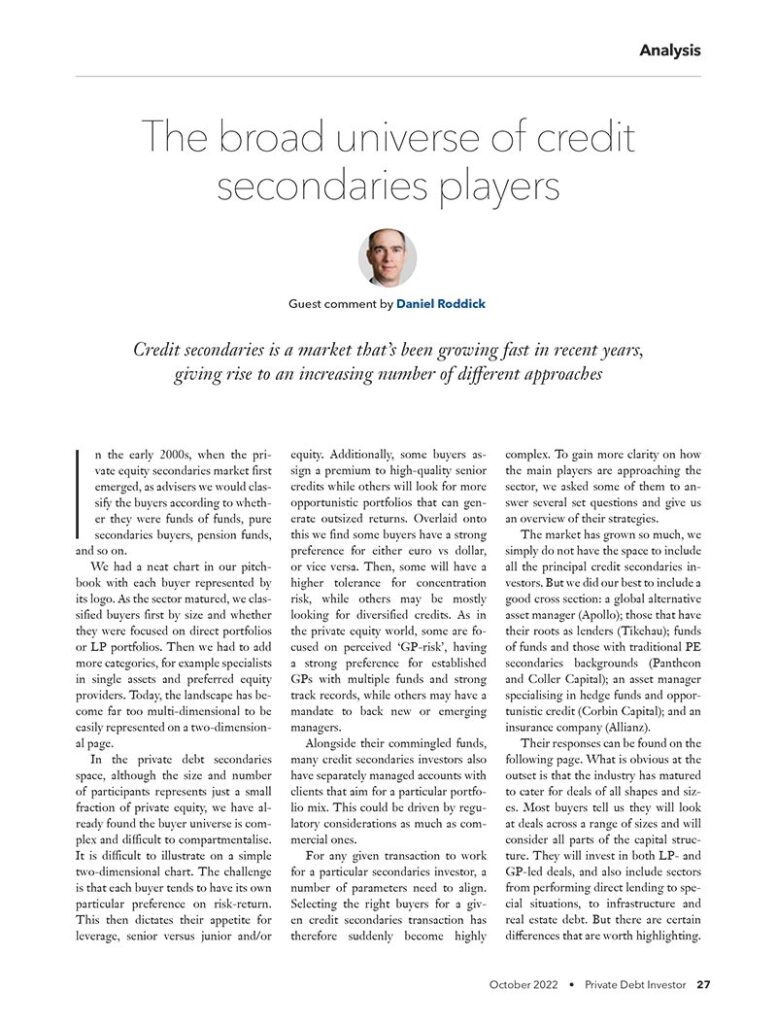The broad universe of credit secondaries players
Private Debt Investor
Daniel Roddick
3 October 2022
‘Credit secondaries is a market that’s been growing fast in recent years, giving rise to an increasing number of different approaches’
Daniel Roddick writes guest commentary for PDI. Click on the article to be redirected to the Private Debt Investor’s online page.

Click below for the original article:
In the early 2000s, when the private equity secondaries market first emerged, as advisers we would classify the buyers according to whether they were funds of funds, pure secondaries buyers, pension funds, and so on.
We had a neat chart in our pitch book with each buyer represented by its logo. As the sector matured, we classified buyers first by size and whether they were focused on direct portfolios or LP portfolios. Then we had to add more categories, for example specialists in single assets and preferred equity providers. Today, the landscape has become far too multi-dimensional to be easily represented on a two-dimensional page.
In the private debt secondaries space, although the size and number of participants represents just a small fraction of private equity, we have already found the buyer universe is complex and difficult to compartmentalise. It is difficult to illustrate on a simple two-dimensional chart. The challenge is that each buyer tends to have its own particular preference on risk-return. This then dictates their appetite for leverage, senior versus junior and/or equity. Additionally, some buyers assign a premium to high-quality senior credits while others will look for more opportunistic portfolios that can generate outsized returns. Overlaid onto this we find some buyers have a strong preference for either euro vs dollar, or vice versa. Then, some will have a higher tolerance for concentration risk, while others may be mostly looking for diversified credits. As in the private equity world, some are focused on perceived ‘GP-risk’, having a strong preference for established GPs with multiple funds and strong track records, while others may have a mandate to back new or emerging managers.
Alongside their commingled funds, many credit secondaries investors also have separately managed accounts with clients that aim for a particular portfolio mix. This could be driven by regulatory considerations as much as commercial ones.
For any given transaction to work for a particular secondaries investor, a number of parameters need to align. Selecting the right buyers for a given credit secondaries transaction has therefore suddenly become highly complex. To gain more clarity on how the main players are approaching the sector, we asked some of them to answer several set questions and give us an overview of their strategies.
The market has grown so much, we simply do not have the space to include all the principal credit secondary investors. But we did our best to include a good cross-section: a global alternative asset manager (Apollo); those that have their roots as lenders (Tikehau); funds of funds and those with traditional PE secondaries backgrounds (Pantheon and Coller Capital); an asset manager specialising in hedge funds and opportunistic credit (Corbin Capital); and an insurance company (Allianz).
Their responses can be found below. What is obvious at the outset is that the industry has matured to cater for deals of all shapes and sizes. Most buyers tell us they will look at deals across a range of sizes and will consider all parts of the capital structure. They will invest in both LP- and GP-led deals, and also include sectors from performing direct lending to special situations, to infrastructure and real estate debt. But there are certain differences that are worth highlighting:
1. Deal size. Despite being a new asset class, investors have already amassed enough capital to single handedly take on deals of significant size. Coller Capital, which launched its first dedicated credit secondaries fund in February this year, says it can today do deals of over half a billion dollars. Tikehau will similarly consider deals up to $500 million given appropriate diversification, Pantheon will bring in co-investors to deploy up to $600 million, and newcomer Allianz expects to be able to deploy up to $1 billion in single transactions.
2. Type of deals. When it comes to LP- vs GP-led secondaries, most buyers say they are agnostic. As I have argued in the past, many believe that GP-led deals will come to represent a larger share of the credit secondaries market: “We expect GP-leds to be a growing part of our business as more credit GPs look to the secondaries market for fund liquidity solutions,” says Pierpaolo Casamento, head of private debt secondaries at Tikehau. Corbin Capital’s GP-driven deals have been larger, preferring to avoid sponsor-backed loans, but the biggest portion of their 70 deals closed by number comprises LP positions.
3. Risk appetite. Most respondents told us they will look at deals across all parts of the capital structure, are comfortable with leverage and will price their returns accordingly. Allianz leans more towards the lower risk-return senior side, which is unsurprising given its insurance background. Some have raised flexible pools of capital to target a range of deals. S3 by Apollo, for instance, was launched to target both private equity and private debt secondaries transactions, as well as NAV-based lending. Others have raised dedicated pools of capital to match different underlying risk profiles: “Pantheon strongly believes there is a large spectrum of risk-return profiles within credit, and therefore has dedicated pools of capital to meet varying investor appetites,” says Toni Vainio, partner at Pantheon.
The private debt secondaries market has seen huge growth, and we expect to see this continue for some time as increasing pools of capital are being raised. While most buyers stress their flexible approach to deals, we do see im- portant distinctions between them. By matching the deal to the most appropriate cost of capital, sellers can ensure they obtain the most competitive price, while GPs can secure the most attractive terms from investors most likely to support them for the longer term.
As deals grow and buyers become more sophisticated, we are likely to see the credit secondaries market evolve in much the same way as private equity secondaries. LP portfolio sales will be split into sub-portfolios where buyers can bid on the whole or on individual parts. In direct credit secondaries transactions, specialist buyers will be able to bid for separate pools of subordinated loans, equity or restructured positions alongside senior, performing assets.
Each GP-led deal tends to have its own idiosyncrasies, making the relationship between the secondaries investor and manager a true partnership formed to solve a particular issue. Although an auction process may be needed to determine the most competitive price, the partnership needs time to develop – usually long before the formal auction kicks off.
As the market evolves, Ely Place Partners will try its best to track the buyer universe. If anyone has any creative ideas on how to visually represent this on a two-dimensional page, then they are welcome to get in touch.


